Asus V9999 Gamer Edition Videocard Review
Ahh, I
remember the days when my trusty old Pentium 100 could handle any game I
threw at it. Upgrade the videocard for better frame rates? What are you talking about;
3D accelerators weren't even invented yet! ;-) These days, the
games are exceptionally demanding, requiring consumers to invest in their videocards, memory, and CPU wisely....
and unfortunately quite often. If you want to piece together a gaming machine there
are just so many variables to consider; it needs a fast enough processor, a
good motherboard and of course, an $500 videocard that will make all you friends
drool!
But this is all rather frightening if you think
about it. A high end videocard costs about the same as an as entry
level PC! Finding the right videocard for your gaming needs, all without
breaking the bank is a hugely difficult task. This is where PCstats comes in;
you've got a friend in the business, and we're here to give you the low down on
all the latest gear!
Over the next several pages, PCstats.com will be
testing the brand new, nVidia-based Asus V9999
Gamer Edition videocard. This baby is a beast, and behind
its shinny exterior rests the precious nVidia GeForce 6800 GPU. Like
many GeForce 6800's, the Asus V9999 Gamer Edition is equipped with
256MB of DDR3 memory. Oh, I can almost hear those Quake 3 pixels
shaking with terror. ;-)
 |
|
Asus V9999 Gamer Edition |
|
|
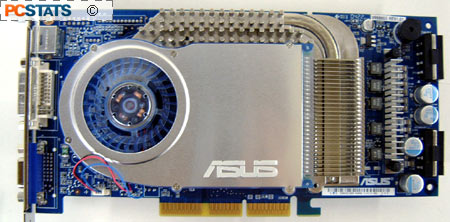
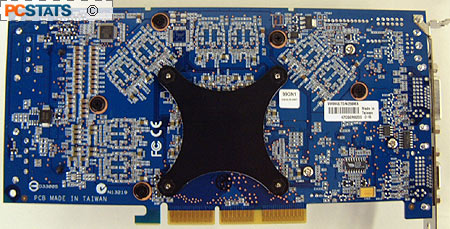 |
| Includes: |
|
Driver CD, Quick Setup Guide, S-Video to
Composite Cable, DVI to analog converter, PowerDirector, Ulead
Cool 3D SE, Ulead Photo Express SE, Media @ Show SE, Asus DVD,
Deus Ex: Invisible War, Gun Metal, Battle Engine Aquila, five
game demo CD |
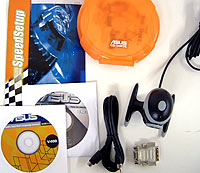 | | |
The card
is based on the standard Geforce 6800 Ultra PCB, and within the
massive box you'll find necessities like an S-Video to composite cable for
those days when you want to take advantage
of the TV Out feature, a DVI to analog converter, a neat looking webcam, and
a pretty decent software suite!
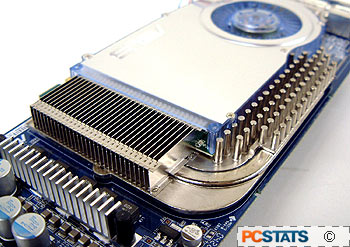 The heatsink Asus have chosen
for this gigantic videocard is loosely based on the nVidia thermal reference design, but with
a few Asus-only touches. For starters, if you peer down into the fan when this baby
is all fired up, you notice three blue LED's giving it a suitable electric glow.
The heatsink Asus have chosen
for this gigantic videocard is loosely based on the nVidia thermal reference design, but with
a few Asus-only touches. For starters, if you peer down into the fan when this baby
is all fired up, you notice three blue LED's giving it a suitable electric glow.
At the edge of the aluminum fan
duct cover and to the left of the heatsink fins, Asus has placed six bright
LED's in a line for further effect. In a dark case, the Asus V9999GE
just lights right up! It's very cool, and would look awesome in a
well kept case with a window.
The heatsink itself is another marvel of just how far videocards are advancing. The cooling
system is composed of a couple different parts, which come together to handle
different cooling tasks. In other words, Asus is not using a single heatsink to cool
both the nVidia core and DDR3 memory, each cooling solution is
separate.
Hidden below the aluminum cover
plate is a skived style copper heatsink, bolted right onto
the PCB so you can be sure it isn't going anywhere. Adjacent to that is the
memory cooling solution which is a mix of cast aluminum, heatpipe, and stacked aluminum
fins.
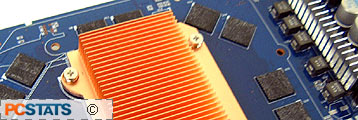 All rather complicated compared to the
inexpensive extruded aluminum heatsinks typically found on ATIs videocards. The
separate heatsinks help keep the GPU and memory cool independently, handy
especially as the core generates a lot more heat than the memory does. Why use
one heatsink to cool down the GPU, and heat up the memory? Doesn't make sense
does it?
All rather complicated compared to the
inexpensive extruded aluminum heatsinks typically found on ATIs videocards. The
separate heatsinks help keep the GPU and memory cool independently, handy
especially as the core generates a lot more heat than the memory does. Why use
one heatsink to cool down the GPU, and heat up the memory? Doesn't make sense
does it?
More Power! I Need More Power!
There were rumors floating around that GeForce
6800 class videocards could run without any external power support.
Unfortunately that is simply not true. At least one molex power connector must
be plugged into the primary header at the rear of the videocard, lest a
shockingly loud high pitched alarm beep infernally to 'remind' you. Apart from this loud warning alarm, the Asus
V9999GE videocard is remarkably quiet, but not too quiet. Compared to some past Asus videocards PCstats
has tested, the V9999GE is modest on the noise front. Although, the videocard fan does not emit a high squealing sound (like a 60mm Delta), so it blends easily into background
noise. You know what they say, with great power comes small amounts of
noise.

